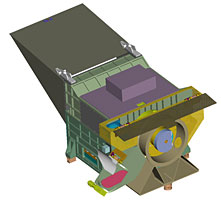Glory APS Science
Aerosols play a crucial role in climate forcing and can contribute to both warming and cooling of the Earth's atmosphere and surface. Black carbon aerosols can contribute to global warming by absorbing the Sun's radiation and re-radiating the Sun's energy as infrared radiation that is trapped by the earth's atmosphere in much the same way that the windshield of a car contributes to a parked automobile heating up in the summer's sun. Sulfate aerosols, produced from the sulfur dioxide gas that spews out of a volcano or from the burning of sulfur-bearing fossil fuels, reflects the Sun's radiation out into space and typically cause cooling. Aerosols, unlike greenhouse gases, have a short lifetime in the atmosphere. After they are produced they interact with other atmospheric constituents including gases, particularly water vapor, other aerosols, and cloud particles, and are transported by the winds before being removed from the atmosphere by sedimentation or rainout over periods of order a week. Because of both natural and anthropogenic (man-made) events, aerosols are constantly being replenished, and the man-made aerosols have been increasing since the beginning of the industrial age. Besides direct interactions of aerosols with radiation, aerosols cause an indirect ( long-term ) cooling effect by modifying cloud radiative properties and modulating precipitation. While it is recognized that aerosols play a key role, because of the uncertainty of the composition of the aerosols in the atmosphere there remains great uncertainty in the effect that atmospheric aerosols have on climate - hotter or cooler, more rain or less.
In the framework of the Climate Change Research Initiative (CCRI) initiated in June 2001 to study areas of uncertainty about global climate change, research on atmospheric concentrations and effects of aerosols is specifically identified as a top priority. One of the activities the CCRI calls out to support this research is improving observations for model development and applications from observing systems. To that end, the Glory mission will deploy an instrument that will help understand the climate-relevant chemical, microphysical, and optical properties, and spatial and temporal distributions of human-caused and naturally occurring aerosols. Specifically, the Glory Aerosol Polarimetry Sensor (APS) will be used to determine:
1. The global distribution of natural and man-made aerosols (black carbons, sulfates, etc.) with accuracy and coverage sufficient for reliable quantification of:
- the aerosol effect on climate
- the anthropogenic component of the aerosol effect
- the potential regional trends in natural and man-made aerosols
2. The direct impact of aerosols on the radiation budget and its natural and anthropogenic components
3. The effect of aerosols on clouds (microphysics and coverage) and its natural and anthropogenic components
4. The feasibility of improved techniques for the measurement of black carbon and dust absorption to provide more accurate estimates of their contribution to the climate forcing
Further Information
APS Science Team
Brian Cairns
APS Instrument Scientist
NASA Goddard Institute for Space Studies
2880 Broadway
New York, NY 10025
APS Team Members
Jacek Chowdhary (GISS/CU)
Igor V. Geogdzhayev (GISS/CU)
James E. Hansen (GISS)
Kirk D. Knobelspiesse (GISS/ORAU)
Li Liu (GISS/CU)
Vanderlei Martins (UMBC)
Michael I. Mishchenko (GISS)
Matteo Ottaviani (GISS/ORAU)
Lorraine Remer (GSFC)
Larry D. Travis (GISS)
Andrzej P. Wasilewski (GISS/Sigma)



